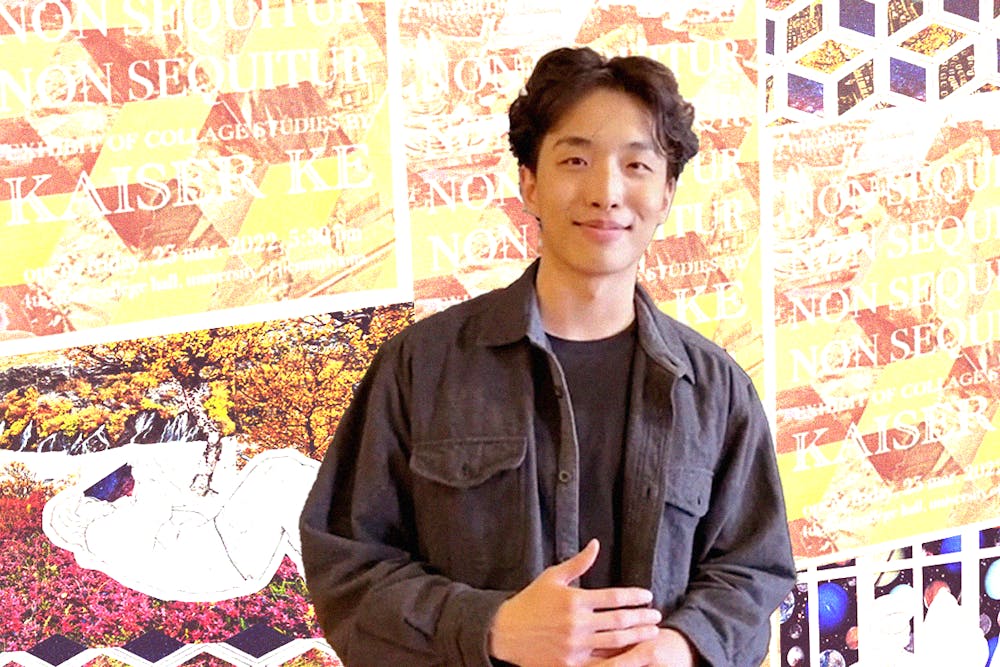In Western art, we tend to look for the artist before the art, curious about the personal secrets hidden in their work. In Kaiser Ke’s (C ‘24) premier exhibit, Non Sequitur, collage is the medium for art that doesn’t need meaning to vibrate with historical, cultural, and compositional resonance. “A non sequitur means a statement that does not logically follow from the previous statement … that is the essence and beauty of collage,” Kaiser says.
One piece in Non Sequitur was created in 24 hours. When you enter the Philomathean Society’s Gallery through the Gothic stairwells of College Hall, you will notice a Parisian cafe suspended in a galaxy. Created during an art relay, Kaiser’s Space Odyssey: 2019 is a cosmic exploration of the bourgeois fashion industry and youth culture, featuring an astronaut in a Thom Browne suit and a regal woman holding a Juul.
References to fashion are in other works along with the display, such as Tessellation of Orange and Green (featured in the exhibition's poster), whose color pairing comes from a Gucci design. But the most recognizable effect of this piece is its shape made of tiling hexagons and rhombuses.
Studying architecture with a minor in art history, Kaiser channels geometry and cultural reflections. He enjoys, as he puts it, “China through the looking glass of the West.” Through repeating patterns or landscape paintings reminiscent of Chinese art, Kaiser is fascinated by the way it was "reduced" by the West during the early industrial period of consumerism. He explains, “Chinese artistic principles are guided by philosophies, such as Taoism or Buddhism, but in the West, it's purely extracting what is aesthetically pleasing to their Western palate.” To Kaiser, this concept applies to the medium of collage itself.
When Kaiser was 2 or 3 years old, his first exposure to art came from his obsession with cars. From telling his mom how to arrange cut–out pictures of them, collage is now a “meditative process” for him. “We tend to associate collage as a kindergarten activity,” but for Kaiser, this only makes it more accessible. Kaiser says that “even a child can digest images and interpret them. … They are not meant to be studies: They’re practices.”
Kaiser’s process of collage tends to come from already existing pieces of his, such as Yosemite Dadaesque. Here, the chair turned on its side was initially only charcoal on paper, but in seeing its negative space, Kaiser textured the background with a mountain range of solid, cut–out colors (typically from National Geographic). He described his almost synesthetic relationship to subjects, saying, “Certain color palettes remind me of a certain culture,” whether it be the cherry blossom pink in Slumber #2 reminding him of Japan or the golden oranges and seafoam greens of Tessellation of Orange and Green feeling Thai. He explains, “Only when you get closer, it’s not just a color gradient, it’s a chaotic background.” In a beach scene in the exhibit, at first, the eye will see its sandy yellows and metallic blues, but when you step forward, these solid backgrounds are full of villages or civil wars. Kaiser sees collage as a “secondary form of art production,” in which he can reincarnate already existing commentary from photography into “the paint [he applies] to the canvas.”
Kaiser believes that “the Penn administration has not yet found a way to commodify visual art.” Penn’s art sphere certainly favors the performing arts, whether it be a cappella groups invited to sing at Convocation or comedy troupes with generations of alumni donors. In a place as business–oriented as Penn, “fine arts [are] inherently decentralized.” But this independence is exactly what Kaiser strives for: to be abstracted from industry and the expectation of being “groundbreaking,” and to keep finding spaces in the world where our forgotten fragments can find a new life to become something whole.
Non Sequitur is open at the Philomathean Society (College Hall Suite 400) during school hours. Access to the Gallery can be found at www.philomathean.org/doorbell.

